As we move towards a more sustainable future, energy efficiency becomes increasingly important. The ErP (Energy-related Products) and Energy Label Directive for LED products are essential components of the European Union’s energy-saving strategies. In this blog post, we will discuss the key updates and requirements for LED products since 2021.
What is ErP and Energy Label Directive?
ErP stands for Energy-related Products, and it also refers to the Energy-related Products Directive (ErP) 2009/125/EC, which superseded the former Energy-using Products Directive (EuP) in November 2009. The initial EuP was adopted in 2005 to meet the Kyoto Protocol’s requirements for reducing carbon dioxide emissions.
The ErP expanded the scope of products covered under the EuP. While the EuP only covered products that directly consumed energy, the ErP directive now also includes products associated with energy, such as water-saving faucets and others.
The goal is to address the entire product supply chain, encompassing the design phase, production, transportation, packaging, storage, and more.
The previous ErP directives EC 244/2009, EC 245/2009, EU 1194/2012, and Energy Label directive EU 874/2012 have been in effect for over a decade. Recently, the European Commission reviewed these regulations, examining the technical, environmental, and economic aspects of lighting products as well as actual user behavior. As a result, the new ErP directives EU 2019/2020 and Energy Label directive EU 2019/2015 were issued.
New ErP & Energy Label Directives Timeline
| Content | Effective Date | Implementation date |
|---|---|---|
| New ErP Directive (EU) 2019/2020 | 2019-12-25 | 2021-09-01 |
| Old regulations (EC) 244/2009, (EC) 245/2009, (EU) 1194/2012 expiry time: | 2021-09-01(were invalid) | |
| New Energy Efficiency Labeling Regulation (EU) 2019/2015 | 2019-12-25 | 2021-09-01 |
| Old regulations (EU) No 874/2012 expiry time: | 2021-09-01(were invalid) | |
| The energy efficiency label of lamps expiry time: | 2019-12-25(were invalid) |
New ErP Directive Scope
This regulation sets eco-design requirements for products entering the market, including:
- Light sources
- Separate control gears
These requirements are also applicable to light sources and control gears included within a containing product.
Light Sources Definition A light source is an electrically powered product designed to emit light or be potentially tuned to emit light. It possesses specific optical characteristics:
- Chromaticity coordinates x and y (only white light in this range, excluding red/green/blue/yellow/pink colors)
- Luminous flux less than 500 lumens per mm2 of projected light-emitting surface area
- Luminous flux between 60 and 82,000 lumens
- Color rendering index (CRI) above 0
Light sources use various technologies, such as incandescent, fluorescent, high-intensity discharge, LEDs, or OLEDs. High-pressure sodium (HPS) light sources that don’t meet the chromaticity condition are still considered light sources. Light sources do not include LED dies, chips, packages, or removable light sources.
Control Gear Definition Control gear refers to one or more devices, possibly integrated into a light source, that prepare the mains electricity for the format required by specific light sources. They ensure electric safety and electromagnetic compatibility and may involve various functions, such as transforming supply and starting voltage, limiting operational and preheating current, preventing cold starting, correcting the power factor, and reducing radio interference. Control gear does not include power supplies within the scope of Commission Regulation (EC) No 278/2009, lighting control parts, non-lighting parts, or Power over Ethernet (PoE) switches.
Separate Control Gear Definition A separate control gear refers to a control gear that is not physically combined with a light source. It can be sold as an individual product or as part of another product that contains it.
Containing Product Definition A containing product is any item that incorporates one or more light sources, separate control gears, or both. Examples include luminaires that can be disassembled for light source verification, household appliances with light sources, and furniture (shelves, mirrors, display cabinets) with built-in light sources. If it’s not possible to disassemble the containing product for light source and separate control gear verification, the entire product is considered a light source.
New ErP directive requirements:
Energy Efficiency Requirements:
(a) Starting from September 1, 2021, the declared power consumption (Pon) of a light source must not exceed the maximum allowed power (Ponmax, in W), calculated based on the declared useful luminous flux (Φuse, in lm) and the declared color rendering index (CRI) as follows: Ponmax = C × (L + Φuse / (F × η)) × R;
In this equation:
- Threshold efficacy (η in lm/W) and end loss factor (L in W) are constants given in Table 1, according to the type of light source. These constants are used for calculations and don’t represent actual light source parameters. The minimum required efficacy can be computed by dividing the useful luminous flux by the calculated maximum allowed power.
- Correction factor (C) values depend on the light source type, and additions to C for special light source features are specified in Table 2.
- Efficacy factor (F) is: 1.00 for non-directional light sources (NDLS, using total flux). To determine if a light source is non-directional, refer to the IES report. 0.85 for directional light sources (DLS, using flux in a cone). The CRI factor (R) is defined as follows:
- 0.65 for CRI ≤ 25;
- (CRI + 80) / 160 for CRI > 25, rounded to two decimal places.
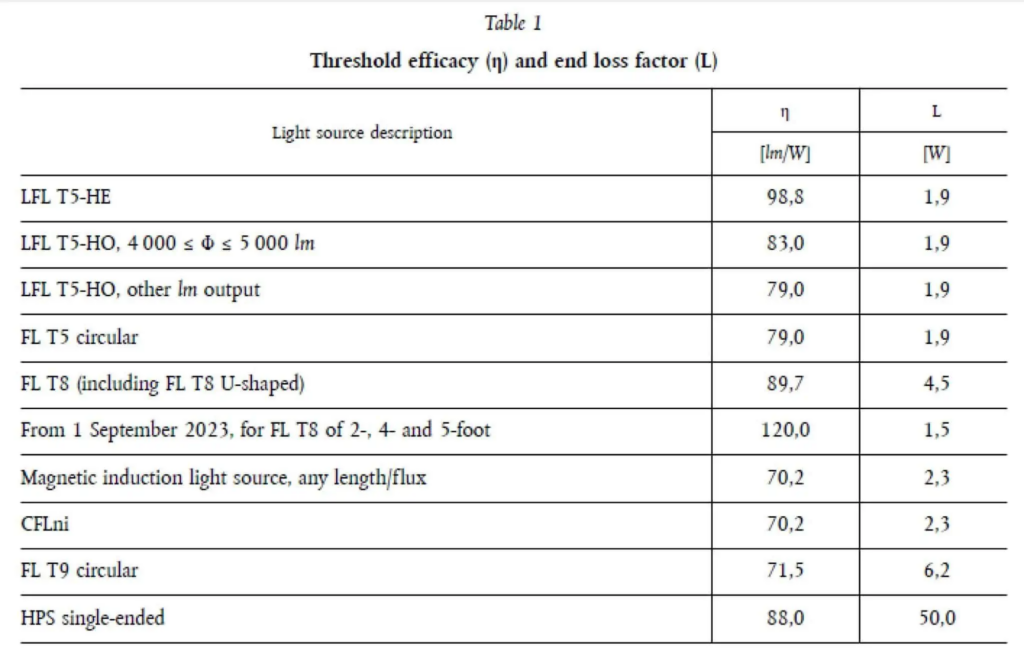
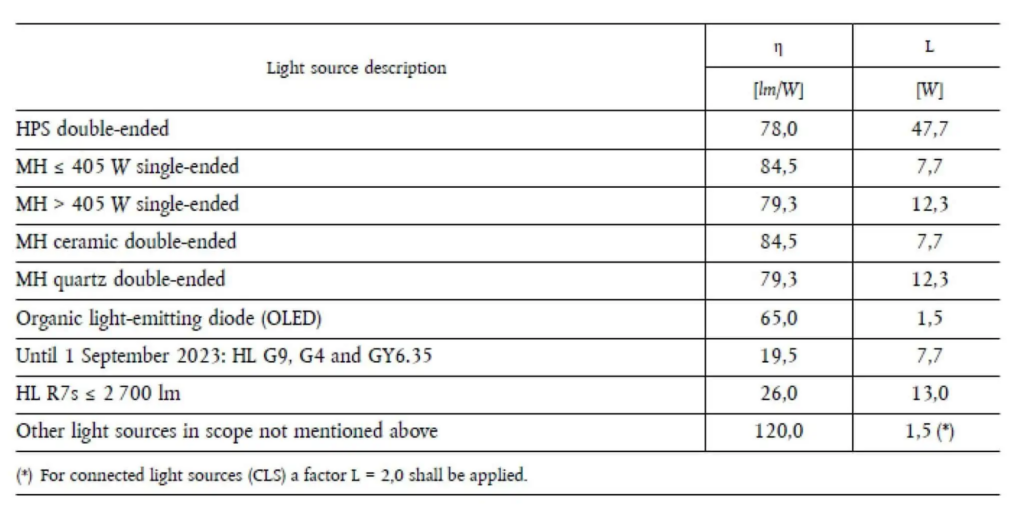
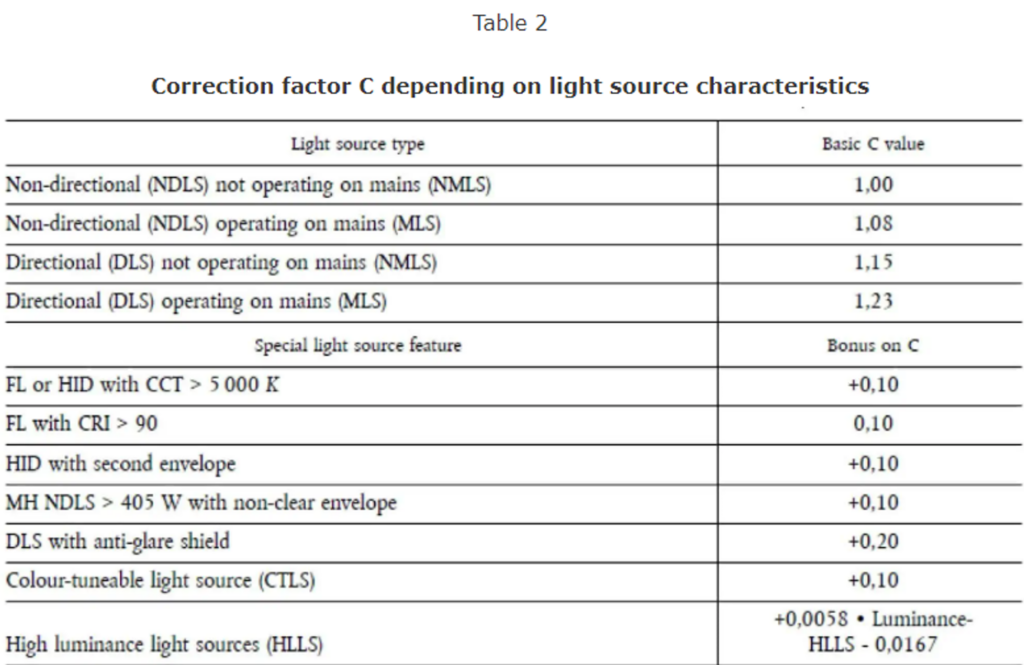
The following provisions apply to light sources and control gears:
Light sources allowing end-users to modify the emitted light’s spectrum, beam angle, useful luminous flux, colour rendering index (CRI), correlated colour temperature (CCT), or directional/non-directional status must be assessed using reference control settings.
For HLLS, the bonus for correction factor C is cumulative, where applicable. The HLLS bonus should not be combined with the basic C-value for DLS; instead, use the basic C-value for NDLS.
The standby power (Psb) of a light source is not to exceed 0.5 W, while the networked standby power (Pnet) of a connected light source must also be limited to 0.5 W. The permissible values for Psb and Pnet should not be combined.
Lastly, as of 1 September 2021, Table 3 outlines the minimum energy efficiency requirements for separate control gears operating at full-load.
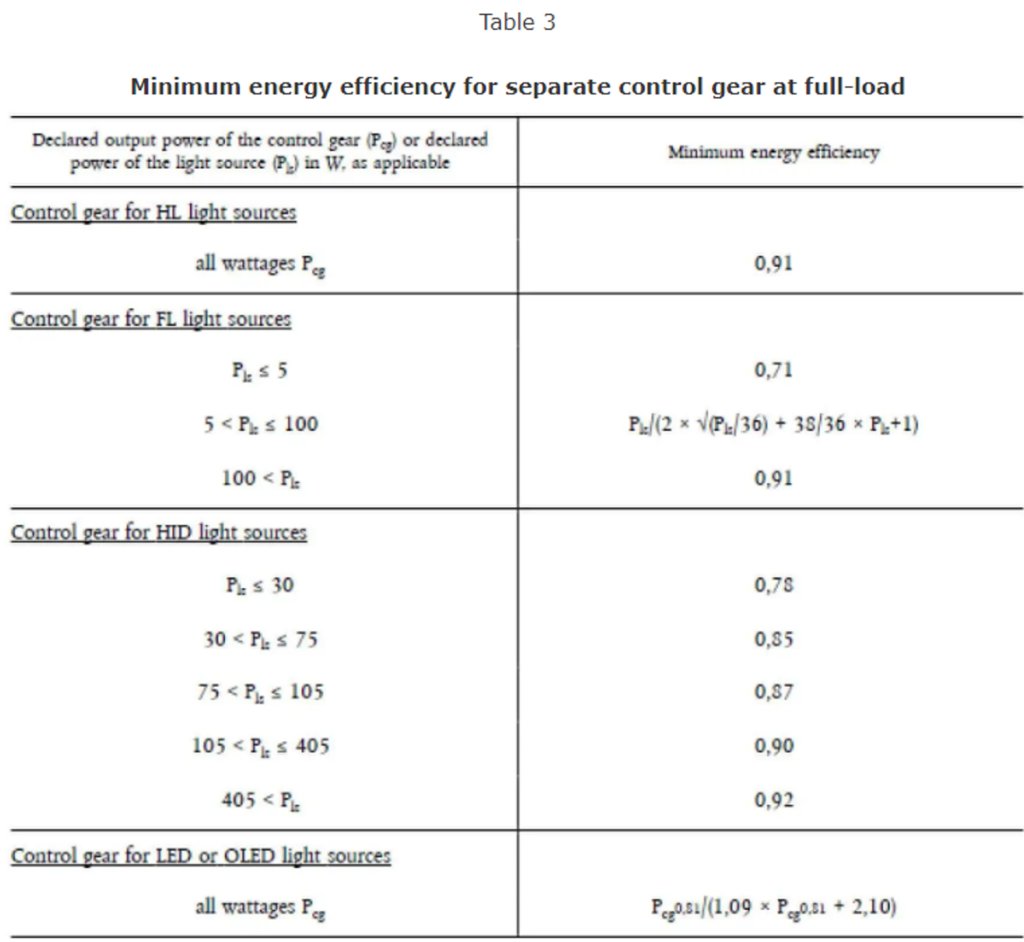
Separate control gears with multi-wattage capabilities must adhere to the specifications outlined in Table 3, based on their maximum declared operating power.
A separate control gear’s no-load power (Pno) should not surpass 0.5 W, but this condition only applies to those designed for no-load mode, as specified by the manufacturer or importer in the technical documentation.
Additionally, the standby power (Psb) of a separate control gear must not exceed 0.5 W. For connected separate control gears, the networked standby power (Pnet) is also limited to a maximum of 0.5 W. It is important to note that the permissible values for Psb and Pnet should not be combined.
Functional requirements
From 1 September 2021, the functional requirements specified in Table 4 shall apply for light sources:
Table 4
Functional requirements for light sources
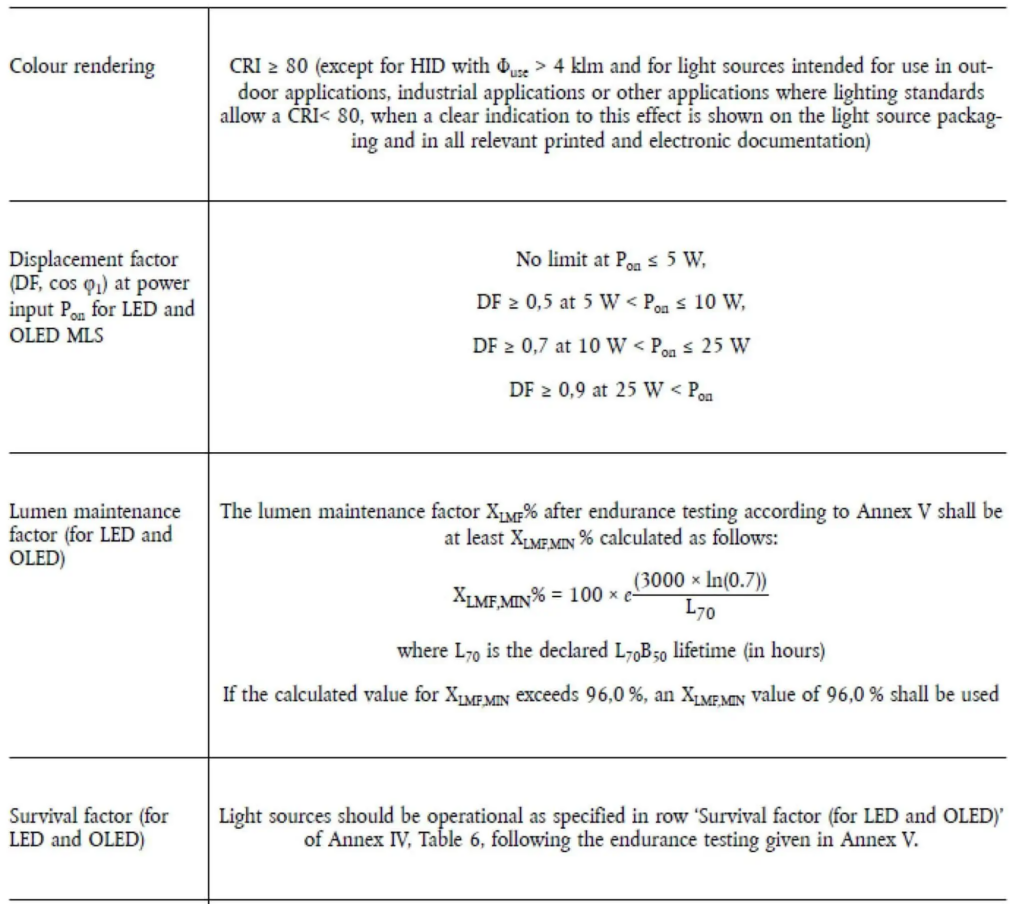
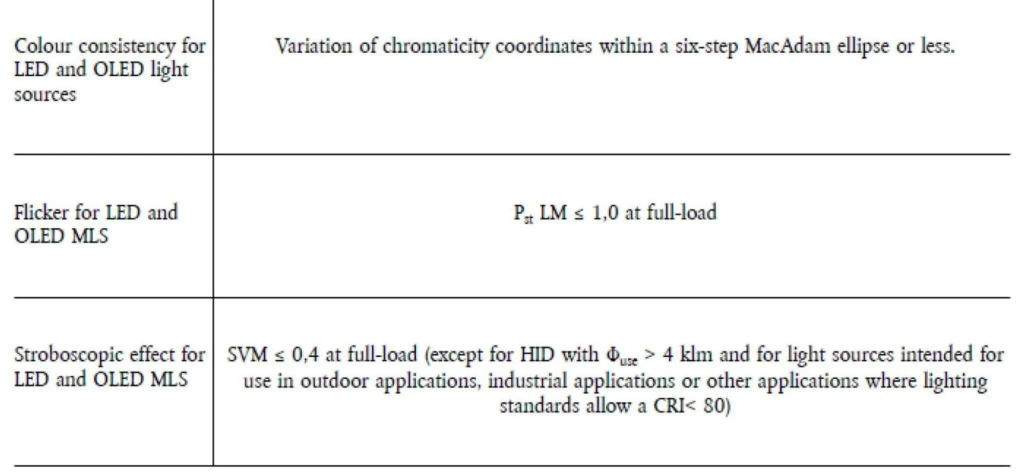
Information requirements
From 1 September 2021 the following information requirements shall apply:
(a) Information to be displayed on the light source itself
(b) Information to be visibly displayed on the packaging
(c) Information to be visibly displayed on a free-access website of the manufacturer, importer or authorised representative
(d) Technical documentation
Energy efficiency classes and calculation method
Energy efficiency label rating calculation formula
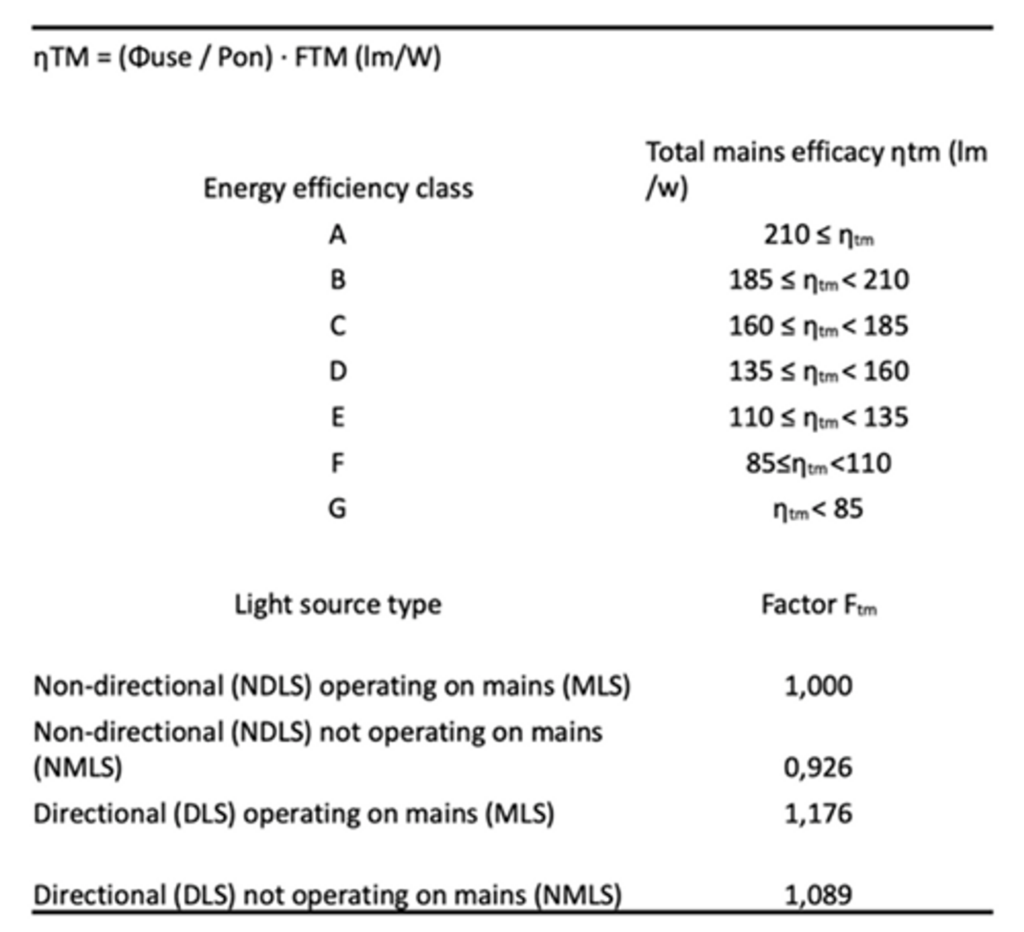
Old versus new classification of the energy label
Advancements in technology will continue to improve bulb efficiency and reduce energy consumption. The new energy label accounts for these future improvements. Consequently, the light bulbs that previously received an A-label (+ or ++) now have a maximum D-class rating. Don’t worry, though; they remain equally energy-efficient.
A comparison table below illustrates the old and new classifications for lamps, including the designated lumens per watt for each class.
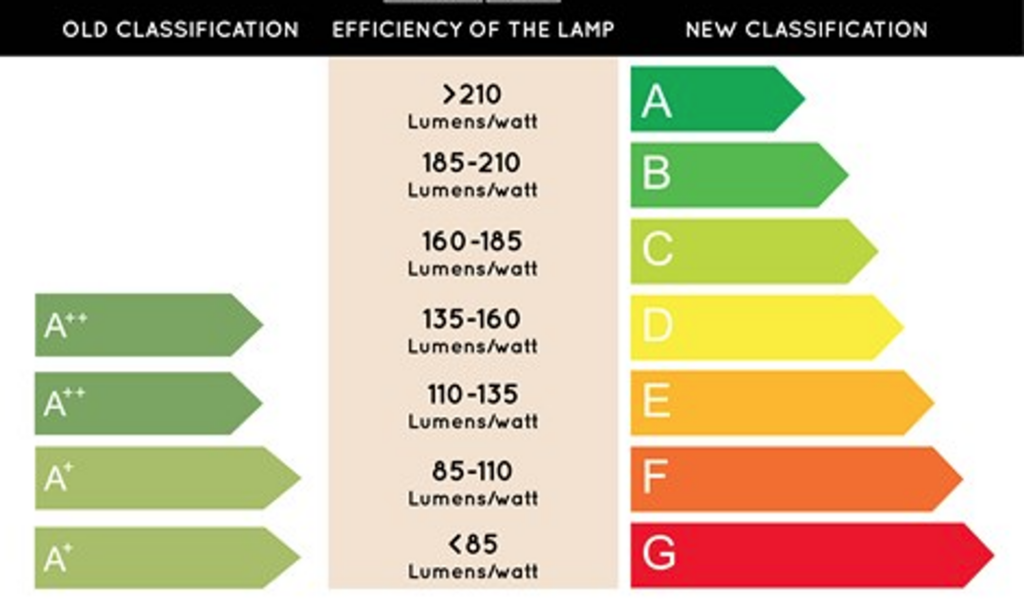
Source: LucideWhat do you find on the new energy label?
- manufacturer’s name
- identification of the model
- the energy efficiency classes, from A to G
- the energy consumption in kWh per 1,000 hours
- a QR code to get additional information
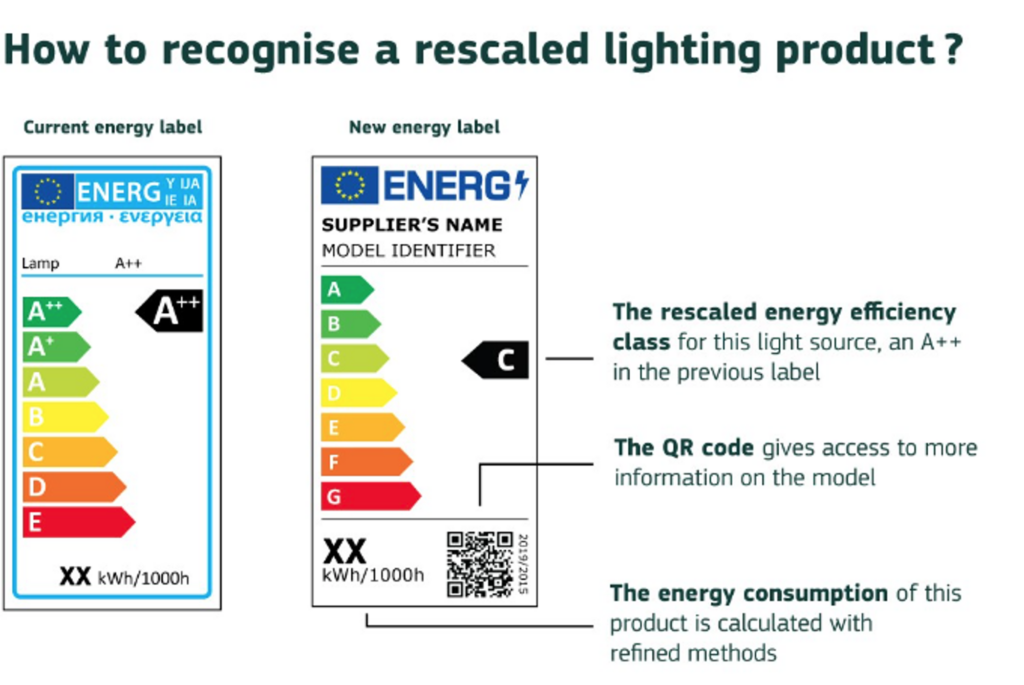
ErP and Energy Label Directive for LED Updates
In 2023, the ErP and Energy Label Directive for LED products will introduce new requirements and updates, aiming to further improve energy efficiency and reduce the environmental impact of LED lighting products. Some key updates include:
- New energy efficiency classes: The EU will introduce new energy efficiency classes for LED products, which will range from A (most efficient) to G (least efficient). This will help consumers make more informed choices when purchasing LED lighting products. Resource
- Stricter energy consumption requirements: LED products will be required to meet more stringent energy consumption limits, ensuring that only the most energy-efficient products are available in the market. Resource
- Product information requirements: Manufacturers will be required to provide more comprehensive product information, including energy efficiency class, power consumption, and other relevant data, to help consumers make informed decisions. Resource
- Recyclability and repairability: The updated directive will also emphasize the importance of designing LED products that are easily recyclable and repairable, reducing waste and promoting a circular economy. Resource
Conclusion
The ErP and Energy Label Directive for LED updates will contribute to a more energy-efficient and sustainable future by promoting the use of eco-friendly LED products. It is essential for manufacturers, retailers, and consumers to be aware of these changes and take the necessary steps to comply with the new requirements.
For more information on the ErP and Energy Label Directive for LED products, visit the European Commission’s website.
